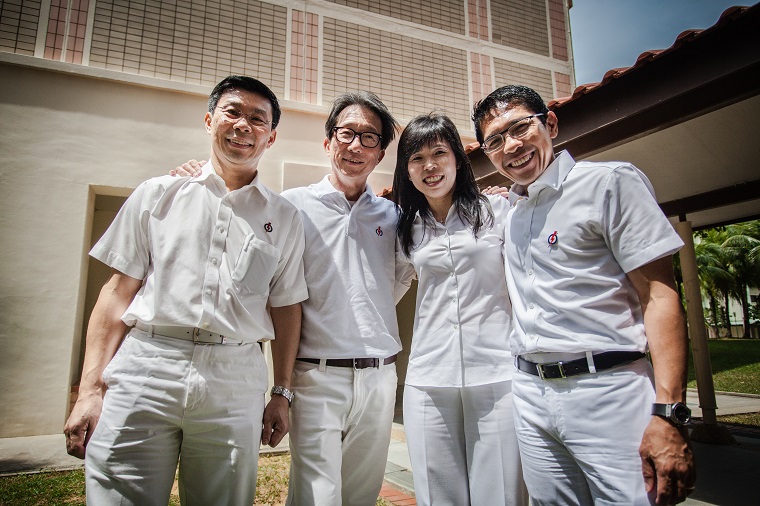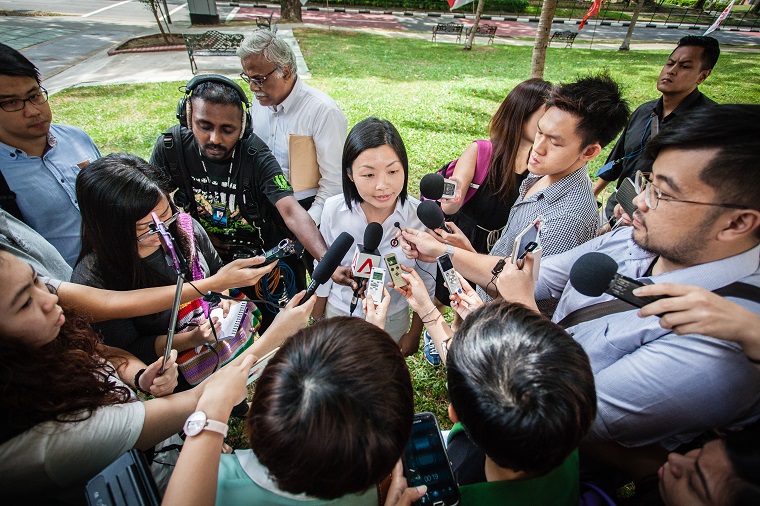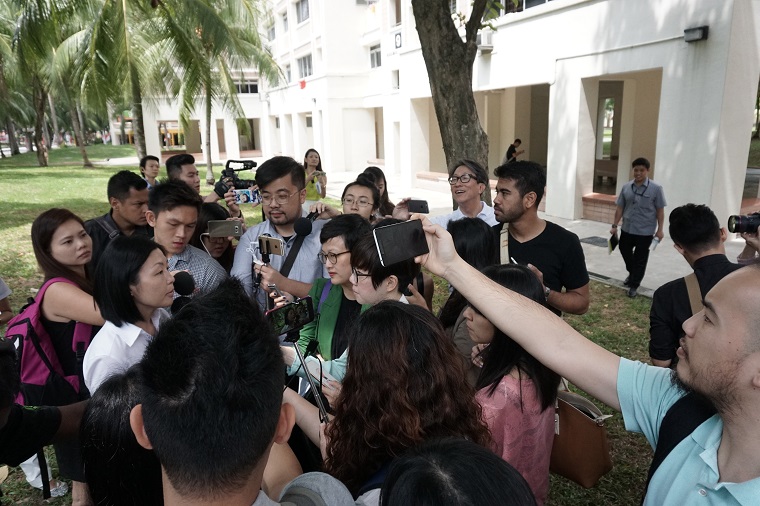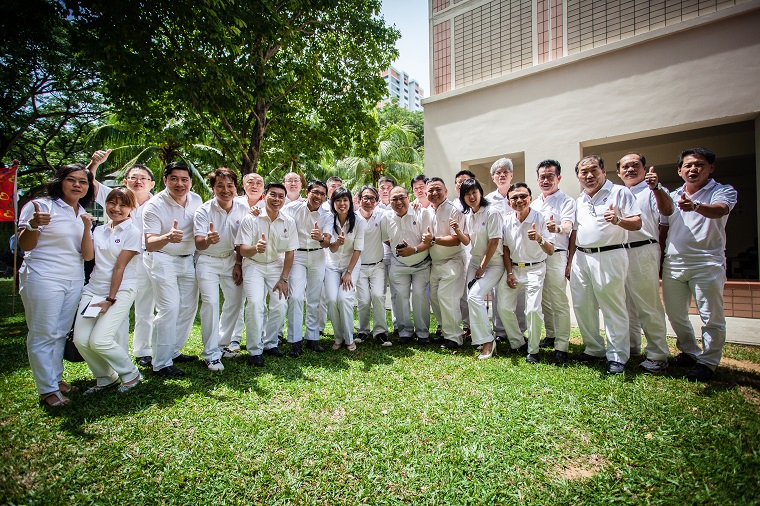Photos by Christopher Wong unless otherwise stated.
The People’s Action Party (PAP) on Thursday (Aug 27) introduced its candidates for the East Coast Group Representation Constituency (GRC), as well as for Fengshan Single Member Constituency (SMC) in the coming General Election (GE).
The four-member team East Coast team will have no new candidate. It will be led by Manpower Minister Lim Swee Say, Minister of State Dr Mohamad Maliki Bin Osman, Senior Minister of State Lee Yi Shyan, and MP Jessica Tan.
Despite the lack of new faces in the team, East Coast GRC will probably be one of the hottest battlegrounds this General Election.
The PAP team in East Coast GRC had the lowest number of votes for the PAP in a GRC for GE2011 when they contested against the Workers' Party (WP) with just 54.8% of the votes.
 L-R: Senior Minister of State Lee Yi Shyan, Minister Lim Swee Say, MP Jessica Tan, and Minister of State Dr Mohamad Maliki Bin Osman
L-R: Senior Minister of State Lee Yi Shyan, Minister Lim Swee Say, MP Jessica Tan, and Minister of State Dr Mohamad Maliki Bin Osman
Fengshan SMC, a ward carved out of East Coast GRC, will see a new candidate Cheryl Chan. She replaces outgoing MP Raymond Lim.
 Centre: Fengshan new candidate Cheryl Chan
Centre: Fengshan new candidate Cheryl Chan
Is the team ready to brace themselves? Because WP is coming.
Here are our 5 observations on what would arguably be the most hotly contested GRC and SMC:
1. New face Cheryl Chan exudes confidence
Several reporters from the mainstream media quizzed Chan on how she felt being fielded in an SMC, especially since she was a new candidate who would be facing the WP.
She took the questions with confidence and reiterated several times that she has been working with residents in Fengshan for the last 10 years and that she had the support of her team of volunteers and activists on the ground. The 38-year-old also added that she would like to help the elderly and less privileged kids if elected.
The Singapore Chinese Girls' School and Catholic Junior College alumna (urban legend has it that people from these schools are jiak kantang one) also took questions in Mandarin competently.
And when asked about the infamous orh luak incident, she said in Mandarin: "Orh luak is not my favourite food. My favourite local dish is laksa. Actually the most famous dish at the Fengshan Market and Food Centre is Bak Chor Mee."
 Spot the minister. Photo by Jonathan Lim
Spot the minister. Photo by Jonathan Lim
2. 9% fall in votes message received loud and clear
Between 2006 and 2011, the PAP East Coast team suffered a 9 per cent vote swing. Minister Lim and his East Coast team addressed this fact by sharing that they took this as a feedback from voters - which shaped the way the East Coast GRC team engaged residents since 2011.
And according to Minister Lim, this means it's time for "Deep Engagement and Mass Personalisation".
What does that mean? Read on.
3. On brand with Deep Engagement and Mass Personalisation
The anchor minister opened his address by describing East Coast GRC as "No change but big change". Okay before you say "upturn the downturn", Lim explained: "No change in our competition but big change in our way of serving the community and the nation."
And the big change led to the implementation of 'deep engagement and mass personalisation', which was PAP's strategy of engaging residents in East Coast post-2011.
To really ram (hehe) home the point, he said the phrase 'deep engagement and mass personalisation' no less than 10 times throughout the press conference.
Explaining that the GRC is sometimes run like five different SMCs (including Fengshan) with overarching synergies of a GRC, Minister Lim elaborated that the team has increased the frequency of house visits since 2011 and enacting improvements that are personalised to residents' needs.
If Lim is a hipster (which is not too far off from the truth with his fitting jeans), then his strategy can be summed up with just one hipster word: bespoke.
4. Lim Swee Say can really be a lecturer
When tackling the hard question of foreign manpower in Singapore, Lim played lecturer and explained the reason why the government was liberal in bringing in foreign workers.
He spoke of the period between 1997 to 2003 which saw various global crises (1997: Asian Financial Crisis, 2000: Bursting of dot com bubble, 2001: September 11, 2003: SARS) being played out. These events saw Singapore's economy yoyo-ing like mad.
He then went on to his lecture proper:
"Whenever economy went down, retrenchment went up. And when retrenchment went up, more workers were affected.
The government came to the conclusion that one better way to protect the interest of the Singapore workers from all these ups and downs is by expanding the size of the workforce by going for higher growth. As the Chinese saying goes: "水涨船高", when the water level is high, your boat can float higher and therefore give yourself some buffer.
So in a sense, the foreign manpower provide this kind of buffer for our local workforce from all these fluctuation in the economy. That strategy worked for 10 years because during that 10-year period, globally unemployment went up and stay high... Secondly, there's wage stagnation around the world. But because of our higher growth policy and more liberal in bringing in foreign manpower, we were able to stay away from unemployment. We were able to stay away from wage stagnation.
So the gain for our Singapore workforce is less retrenchment. Also, wages went up, not just in nominal but real terms. The pain is basically the ratio of local workers to foreign workers has been dropping from three-to-one to two-to-one. So in 2010, before GE 2011, we already did a review and decided that for the next 10 years we should adopt a different strategy. No longer high manpower growth policy but rather to moderate the growth of the foreign workforce in Singapore. Therefore, the policy commitment is to maintain the ratio of 2:1 rather than let it continue to drop to eventually 1:1 or Singaporeans becoming a minority in our workforce"
5. It was kinda like a job interview
Perhaps due to the extended time he spent as a Minister without a portfolio in the Prime Minister's Office and concurrently as the Secretary-General of NTUC, Singaporeans may not know what Minister Lim did while in office. The Manpower Minister went on about his role as Acting Minister of Environment (Convincing Singaporeans about NEWater! Raising public hygiene standards during SARS!), his NTUC days (Better jobs for all! Progressive Wage Model!) and now as Manpower Minister, a role he just took over from Minister Tan Chuan-Jin this year. He also said that he would really wish to implement his manpower policies (hint hint).
The rest spoke about how they helped the bottom 20% (Dr Mohamad Maliki Bin Osman), rejuvenation of a 37-year-old town (Lee Yi Shyan) and dialogue sessions with the electorate (Jessica Tan).
Very timely.
If you like what you read, follow us on Facebook, Instagram, Twitter and Telegram to get the latest updates.


